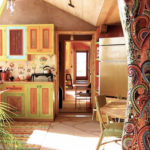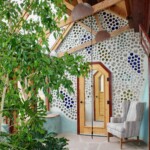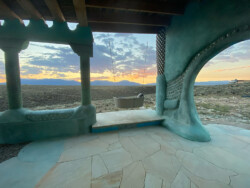What the Heck is an "Earthship" ?!?
- rickmarshall9
- Nov 13, 2024
- 5 min read
Updated: Mar 27

Earthships: An Overview
Definition
Earthships are sustainable buildings designed to be self-sufficient and environmentally friendly. Developed by architect Michael Reynolds, they use natural and recycled materials
to create homes that aim to be off-grid and completely self-sustaining. These structures incorporate passive solar design principles, natural ventilation, and innovative systems for water, energy, food production, and waste management.

History
The concept of Earthships began in the 1970s, during a time when environmental concerns and sustainable living practices were gaining momentum. Michael Reynolds, a New Mexican architect, pioneered the design to address the growing need for affordable, eco-friendly housing. The first Earthships were constructed in Taos, New Mexico, and the concept has since evolved, with numerous Earthship communities and individual homes built worldwide.
Today
In addition to constructing Earthships anywhere in the world (and establishing whole Earthship communities), Mr. Reynolds’ company, “Earthship Biotecture” offers an academy (both in-person and on-line), which provides extensive training in Earthship design principles, construction methods, and philosophy. Academy classes, labs, tours, and hands-on construction techniques are led by top Earthship builders, electricians, plumbers, and plant specialists. They also offer a limited number of “half-scholarships” for qualified individuals. [For information regarding Earthship Academy, visit: Learn - Earthship Biotecture]. For the environmentally and self-sufficiency-minded DIY’er, Earthship Biotecture also offers construction drawings/plans, starting at just over $2000. [https://earthshipstore.com/collections/construction-drawings-offgrid ] Several books are available, as is their interesting monthly newsletter. It is impossible to read their articles and not get “the bug” to adopt this philosophy and consider working with them. ….Internships are also available.
If you are excited about the concept of Earthships and are curious to see some, the company offers self-guided tours. If you would like to see if they are for you, I recommend booking a stay for a little while (2-night minimum) to really get a taste for what they are all about. The rental fee can be a little steep depending on the location you choose, but there is no better way to experience first-hand, this lifestyle and all these innovative homes have to offer. The company’s website states, “ Earthship nightly rentals allow people to experience a luxurious off grid life. Being self-sufficient does not mean reducing one’s quality of life. The Earthship rental homes are equipped with all amenities that conventional housing provides, including Internet and Netflix, flat screen TV, refrigeration, propane oven, cookware, place settings, hot water and linens. Most of our Earthships rentals are located at the Greater World Earthship community in the beautiful scenic setting of the Sangre de Cristo mountains near the town of Taos, New Mexico. “ Visit: Nightly Earthship Rentals - Earthship Biotecture , email: reception@earthship.com or call 575 – 751 – 0462.
Benefits
Energy Efficiency: Earthships are designed to use minimal external energy sources. They often feature thick, insulated walls made from recycled tires, which provide excellent thermal mass, maintaining a stable indoor temperature with minimal heating or cooling.
Sustainability: These buildings utilize recycled materials, such as tires, bottles, and cans, which help reduce waste. They also incorporate renewable energy sources, like solar panels and wind turbines, to power the home.
Water Management: Earthships are equipped with systems for rainwater harvesting, greywater recycling, and sewage treatment. This enables them to be self-sufficient in water needs, reducing or eliminating dependence on municipal water systems.
Self-Sufficiency: By integrating organic food production through indoor gardens and greenhouses, Earthships support a degree of food autonomy, further enhancing their sustainability and food-cost reduction. (Consider the benefit and freedom of self-sufficiency to your overall wellbeing!)
Cost-Effectiveness: The use of recycled materials and off-grid technologies can lead to lower long-term costs, despite potentially higher initial investment. (Lower food costs, lower or no energy cost, lower or eliminated HVAC costs, reduced or eliminated water cost, etc.)
Drawbacks
Initial Costs: Building an Earthship can require a significant upfront investment. The cost of acquiring land, constructing the home, and installing systems for energy, water, and waste management can be high, although this is often offset by long-term savings.
Regulatory Hurdles: Earthships can face challenges with building codes and zoning regulations, which vary by location. The unconventional design and use of recycled materials may not always meet local construction standards. When choosing a builder, doesn’t it make sense to select a company with many years of experience navigating this process and which knows the intricacies of this type of construction?
Maintenance: While designed for self-sufficiency, Earthships require ongoing maintenance and monitoring of systems to ensure they function correctly. This can be more demanding than traditional homes.
Aesthetic and Functional Limitations: The distinctive design of Earthships may not appeal to everyone. Additionally, some aspects of the homes, such as thermal mass walls, can limit flexibility in interior layout and design. This is by no means a nice way of saying these homes are ugly! In fact, they are (in my opinion), beautiful in many ways.
All photos of Mr Reynolds and Earthship construction used with permission of Mr. Reynolds.
Cost
The cost of building an Earthship varies widely depending on location, size, and design complexity. On average, constructing an Earthship can range from $150 to over $300 per square foot. This range reflects the diverse materials and technologies used, from recycled tires and cans to advanced renewable energy systems. Additionally, the cost of land, labor, and local building code compliance can influence the overall price.
Future Outlook
The future of Earthships appears promising as global awareness of climate change and sustainability grows. Several factors contribute to this optimistic outlook:
Technological Advances: Innovations in building materials and renewable energy technologies are likely to enhance the efficiency and affordability of Earthships. Improved technologies in solar power, water filtration, and waste management could make Earthships even more viable and cost-effective.
Increased Interest in Sustainability: As more people seek sustainable living solutions, Earthships are gaining popularity. This growing interest may lead to greater acceptance and integration of Earthship designs into mainstream architecture.
Supportive Policies: Government incentives and policies promoting green building practices could help address regulatory barriers, making it easier to construct and finance Earthships.
Community Development: Earthship communities and eco-villages are emerging around the world, providing models for sustainable living that can inspire and inform future projects. These communities often showcase successful integration of Earthship principles and offer valuable insights for replication.
Educational Opportunities: As educational institutions and workshops increasingly focus on sustainable building practices, knowledge about Earthships and their benefits is likely to spread. This education can lead to more skilled builders and designers proficient in Earthship construction.
Conclusion
Earthships represent a compelling solution for those seeking to live more sustainably and independently. While they offer significant benefits, including energy efficiency, sustainability, and self-sufficiency, they also come with challenges related to cost, maintenance, and regulatory approval. Despite these drawbacks, the evolving landscape of technology and sustainability suggests a very bright future for Earthships, as they continue to inspire new ways of living in harmony with the environment. Visit: https://earthship.com/


















Comments